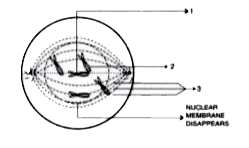The number of daughter cells formed at the end of meiosis from a cell are.
2 Haploid cells
2 Diploid cells
4 Haploid cells
4 Diploid cells.
Step-by-Step Solution:
1. Understanding Meiosis: Meiosis is a type of cell division that reduces the chromosome number by half, resulting in the formation of gametes (sperm and eggs). It consists of two main stages: Meiosis I and Meiosis II.
2. Meiosis I: In the first stage, Meiosis I, the cell undergoes a reduction division. This means that the homologous chromosomes are separated. At the end of Meiosis I, two daughter cells are formed, each with half the number of chromosomes (haploid).
3. Meiosis II: The second stage, Meiosis II, resembles mitosis. The two haploid cells from Meiosis I undergo another division. During this stage, the sister chromatids of each chromosome are separated.
4. Final Outcome: After Meiosis II, the two haploid cells divide again, resulting in a total of four haploid daughter cells. Each of these cells has half the number of chromosomes compared to the original cell.
5. Conclusion: Therefore, the answer to the question is that the number of daughter cells formed at the end of meiosis from a single cell is 4 haploid cells.
Topper's Solved these Questions
Similar Questions
Knowledge Check
The two daughter cells produced at the end of meiosis I when compared to the parent diploid cell will have:
Asame amount of DNA and same number of chromosomes.Bsame amount of DNA and half number of chromosomes.Chalf amount of DNA and half number of chromosomes.Dhalf amount of DNA and same number of chromosomes.
Two daughter cells formed after mitosis are
View SolutionHow many daughter cells are formed at the end of mitosis and at the end of meiosis?
View SolutionGiven below is a diagram representing a stage during mitotic cell division in an animal cell:

Mention two points of difference between 'mitosis' and 'meiosis' with regard to :
The number of daughter cells formed.
The chromosome number in the daughter cells.
View SolutionA cell with 2n=16 undergoes meiosis. Each of the four daughter nuclei formed at the end of the division will have
View SolutionDaughter cells formed after mitosis resemble to their mother cell but daughter cells formed after meiosis different from mother cells:
View SolutionWhat is the difference in the chromosome number of daughter cells produced by meiosis I and meiosis II?
View SolutionFour daughter cells formed after meiosis are
(a) Genetically similar
(b) Genetically different
(c) Anucleate
(d) Mutinucleate
View Solution
